We, in our home, have been using a bedside commode for several years for my mom, since she had hip replacement surgery, and I can say that my mom’s satisfaction with it is complete. Our commode is a 3-in-1, which is a simple, but really useful, piece of equipment and has made life a lot easier. For anyone with reduced mobility and balance problems, a bedside commode can be a great help.
What are the main reasons for using a bedside commode –
- if you are bedridden
- if you can’t get to the toilet on your own
- if you use a wheelchair
- if you can’t get to the toilet in time – mobility issues make you too slow
- if you need a toilet safety frame
- if you need to raise the height of your toilet seat
- if you are frail and sitting on a toilet is difficult
- if you have problems with balance and need supports to hold on to
- if you pee a lot at night and walking to the toilet is risky
- if you have had a surgery and sitting down low is difficult
- if you have had hip replacement surgery
- if you have had knee replacement surgery
Content Overview and Quicklinks
What is a 3-in-1 bedside commode ?
8 Reasons for a bedside commode –
- For an individual who is bedridden
- For a person who cannot get to the toilet on their own
- If you can’t get to the toilet quick enough because of mobility issues
- For use as a toilet safety frame
- For use as a raised toilet seat
- For an elderly loved one who is suffering from arthritis
- If you go to the bathroom a lot at night, and it is risky
- For a person who has had hip or knee replacement surgery
How to transfer from a bed to bedside commode ?
What is a bedside commode ?
A bedside commode is a form of chair/toilet which does not use running water, and requires no plumbing. It can be placed by the bed, or at any location where it is needed.
It has the frame of a chair but with a toilet seat, under which a bucket or pale is slotted in place, so it may be used as a toilet – they are light enough to be portable and easily moved if need be.
There are two main types of bedside commodes –
- static portable bedside commodes
- rolling bedside commodes
Static commodes are those without wheels, and rolling bedside commodes are those with wheels.
So, let’s start with the different types of static bedside commodes and the reasons that you would need to use one.
Static bedside commode types –
- simple folding commode
- stacking bedside commode
- 3-in-1 commodes or All-in-One commodes
- drop arm commodes (this can be a specific type or a feature that you find on other types)
- static shower commode
Below are some illustrations of 5 types of bedside commode I mentioned above.
While you are looking for bedside commodes, there is lots more that you can do to make your bathroom a safer place for seniors, or anyone else with mobility issues.
To find out all the different things you can do, to have an instant impact on bathroom safety, take a look here, “54 Bathroom Safety Tips For Seniors – A Helpful Guide”.
Bedside commodes – portable
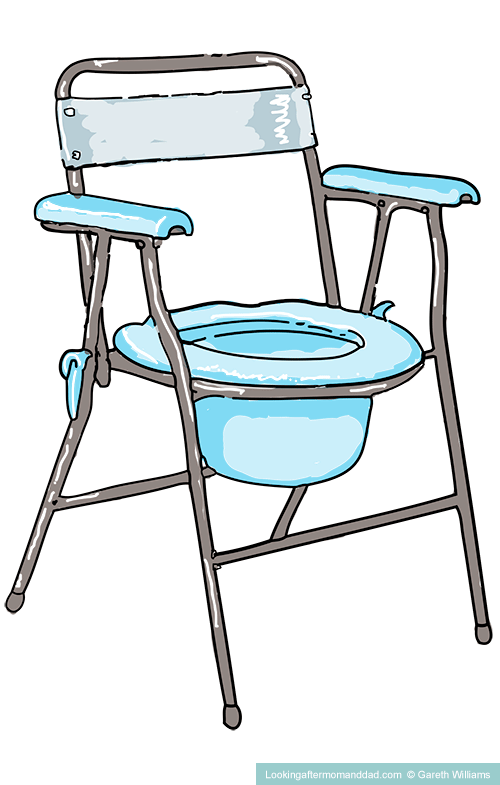
Static folding bedside commode
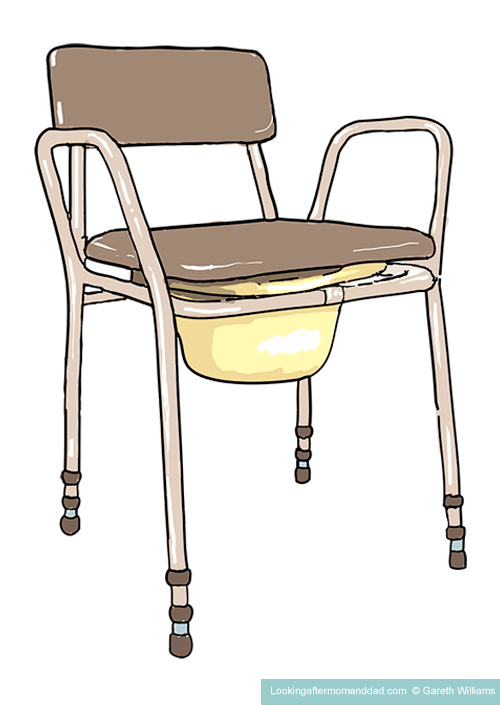
static stacking bedside commodes
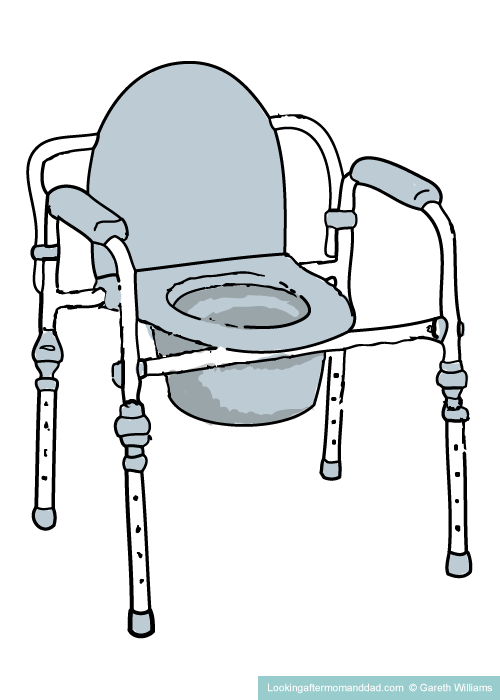
3 in 1 bedside commode
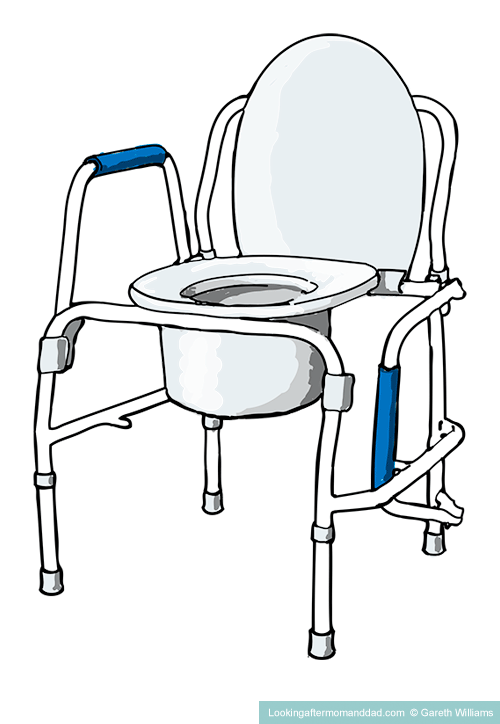
Drop arm bedside commodes

Static shower bedside commodes
- padding
- elongated seats
- open front seats
- extra width seats
- extra width frames
- extra tall frames
All of which you will choose depending on your needs and reasons for getting a bedside commode.
There is what is often described as another type of commode – a “bariatric” or “heavy duty” commode, but it is simply a commode which takes extra weight and is usually a 3-in1 commode which is wider and stronger than the standard.
The standard commode of all the static commodes can support up to at least 250 lb, unless they state otherwise, and a lot will support 300 lb.
Bariatric versions of bedside commodes are built to support over 350 lb, and depending on the model can support over 1000 lb in weight. You have to check each different model for their weight capacity – don’t assume that they can support a weight without checking.

Bariatric bedside commode
To learn more about bariatric commodes, you can read my article “What is a bariatric commode ?”,
which covers –
- static bariatric commode features
- elongated seats
- elongated seats with extra wide frames
- extra wide frames with wider seats
- full width seats
- tall bedside commodes
- can you use bariatric commodes over a toilet ?
- how to use a bariatric commode over a toilet ?
- well known brands of bariatric bedside commodes
- rolling bedside commodes
- transport bedside commodes
- shower transport bedside commodes
- attendant bariatric shower transport commode
- self-propelling bariatric shower transport commodes
- well known brands of rolling commodes
- where can you find the widest range of bariatric commodes ?
- where to buy a bariatric commode ?
- how much does a bariatric commode cost ?
And if you are looking for a post which covers all aspects of the different types of bedside commodes –
- the types
- set up
- who needs one
- using over a toilet
- liners emptying
- cleaning
- odor control
- where to buy
- top brands
- bedside commodes for larger people
- using over the toilet
- maintenance
- features
- sizes
- and more
You can find all of that in this article, “What is a bedside commode ?”.
What is a 3-in-1 bedside commode ?
“3-in-1” and “All-in-one” bedside commodes are the most popular type of bedside commode due to the fact that they can be used for 3 different jobs.
They have 3 intended uses –
- as a bedside commode
- over the toilet as raised seat
- a safety frame around a toilet for support
The 3-in-1 commode is a static chair with a seat and lid, and under which is placed a removable potty or pale.
This is the type of commode that we bought for my mom, and we have also used it as a seat when I, or nurses needed to sponge bathe her after a hip replacement, or to put on pressure stockings. If you have a large enough shower it can also be used as a shower chair, if you have a waterproof model.
To learn more about 3- in 1 commodes, you can check my post “What Is A 3-in-1 Commode ? And What Is It Used For ?”. You can find out about –
- Well known brands of 3-in1 bedside commodes
- How to set up a 3-in-1 bedside commode ?
- How to set up a 3-in-1 commode over a toilet ?
- How to set up a 3-in-1 bedside commode as a toilet safety frame ?
- Where can you buy 3-in-1 commodes ?
- Other types of bedside commodes
An if you need to check the weight limits of 3-in-1 commodes, I have a long list of the different models and types, all organized by weight category – “3 In 1 Bedside Commode Weight Limit Guide: With Over 50 Examples”
You will find out about –
- What is a drop arm commode ?
- Static drop arm commodes
- Static drop arm commodes vs a 3-in-1 commodes
- Drop arm transport, or rolling, commodes
- Drop arm or rolling, commodes vs 3-in-1 commodes
- Drop arm shower transport commodes
- Drop arm shower transport commodes vs 3-in-1 commodes
- How to set up a drop arm commode, or a 3-in-1 commode, over a toilet
Reasons for using a bedside commode
Let’s now take a look at each reason I gave at the outset of this post for needing a bedside commode, and which of the bedside commodes above is best suited to that need.
For an individual who is bedridden
For an individual who cannot leave their bed, and who doesn’t want to use a bedpan, a bedside commode is a much more pleasant option.
So long as the person can use their arms, they can slide over and use a “drop arm” commode.
Drop arm commodes (usually a 3-in-1 commode as well) have armrests which are not in a fixed position, as on a standard commode, but which can be moved down out of the way, up out of the way, or can be totally removed, and allow a user to access the commode from the side.
Once the user is back on the commode, the armrest can be returned to its position for safety.
If the user cannot use their arms, they can be placed on a bedside commode with a patient lift, but I would suggest they would need a much more specialist type of commode which would hold them in position if they cannot use their arms or legs to secure themselves.
For a person who cannot get to the toilet on their own
If you have an elderly loved one, or person of any age, who cannot get to the toilet on their own, a bedside commode is a great option if they can stand by themselves, or with help.
You can use any of the commodes for this, but just make sure that the weight capacity is the correct one for the user.
If the user can get out of bed and then sit on the commode, even with help, they can then have some privacy and not lose too much dignity, as is the case with a bedside commode.
Now there is another option for this which I will outline later – a transport commode.
If you can’t get to the toilet quick enough because of mobility issues
For a person who can’t get to the toilet quickly enough because of reduced mobility, a bedside commode is a great option, as they can get out of bed and use the commode in complete privacy. The caregiver will then just have to empty the commode when the user has finished.
Again, for this, any one of the commodes that I listed above can be used for this – you just have to check that you have a commode with the right weight capacity for the user.
For use as a toilet safety frame
For individuals who need some form of support when they sit on the toilet, a 3-in-1 commode, or stacking commode, is a great option.
This is a very good option if you have a frail elderly parent or loved one who has balance, vision or strength issues with sitting on the toilet – all of these problems can really cause an elderly person to lose confidence, and make it even more difficult for them to get seated.
The commode is placed over the toilet, with the seat of the commode at the lowest height setting it can above the toilet rim.
The commode bucket is of course removed, as the toilet is being used instead.
For use as a raised toilet seat
If you have an elderly loved one who needs a raised toilet seat, and they want something really solid, then a stacking commode (a model which can go over a toilet), or a 3-in-1 commode, can be used over the toilet.
These are remarkably solid commodes which big armrests which are a lot more substantial than a basic raised toilet seat, and not at all wobbly like a lot of commodes.
This is what my mom has used for a long time after her hip replacement.
For an elderly loved one who is suffering from arthritis and who needs help sitting
Again you can use it over the toilet and set the commode up to 6 inches higher than the toilet seat, thus making the distance to bend down far less when sitting, and making standing back up far easier.
If the user prefers they can use it as a bedside commode at exactly the same height, so if they don’t like to walk a lot, you can just place it in the same room as they spend the bulk of their time, and they can use it as a toilet there.
If you go to the bathroom a lot at night, and it is risky
Placing a bedside commode in a bedroom near to the bed for an elderly person who needs to go to the toilet at night, but may be a little unsure on their feet when sleepy, can avoid nasty falls.
If they are sleepy, it can be rather dangerous, and people will often forget to turn a light on and stumble around in the dark.
It is a good idea to place a light with a remote sensor in the bedroom which turns on when it detects any movement, as then an elderly person only has to think about using the commode, and if they forget the light it won’t matter. It avoids unnecessary accidents.
For a person who has had hip or knee replacement surgery
For an individual of any age who has had a hip replacement, a bedside commode can be very useful in the first few days in the bedroom, especially at night when a person is sleepy and may make a wrong move without thinking, which when they have had surgery may lead to serious consequences.
I would suggest getting a 3-in-1 commode for after surgery just because it can be used both in the bedroom at night, and in the daytime in any room, or critically over the toilet if the user can walk that far.
For those who have had surgery on their hip or knees the armrests are very important, as you have to sit back gently, and they are easy to see out of the corner of your eye.
One serious point to make about using any commode or chair after surgery is that you need to sit down the way you have been taught to do so at the hospital.
At the time of my mom’s hip replacement, both the nurses and the physiotherapist taught my mom and I how she was to sit, and they were very insistent that I should know how it was to be done as well.
If you want to know which raised toilet seats are best over the toilet, and which bedside commodes are best after a hip or knee replacement, I have two articles which will be helpful to you –
“Best Raised Toilet Seats After A Hip Replacement”
“Best Raised Toilet Seats For Elderly Seniors: A Detailed Guide With Prices”
Rolling commodes
There are two types of bedside commodes on wheels –
- transport bedside commodes
- shower chair transport commodes
These commodes are vital if the user cannot walk much, or at all. They are basically commodes combined with transport chairs and some also with a shower chair.
Both types have an attendant version, and a self-propelling version, like a wheelchair.
The attendant version requires the user to have a caregiver to propel them when it is being used as a transport chair.
Transport or rolling bedside commodes
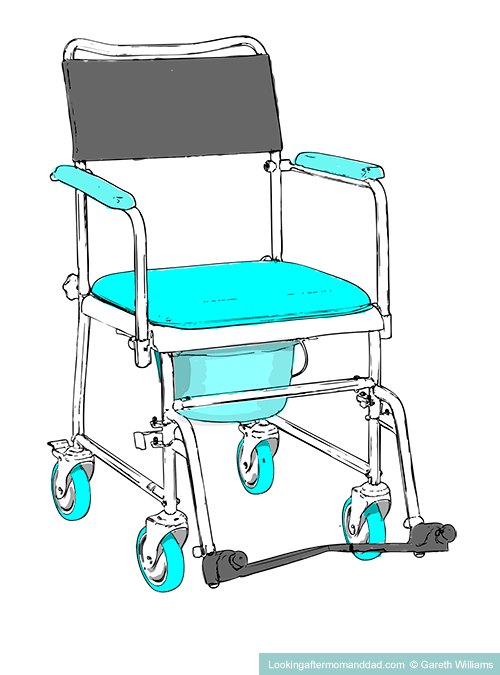
Attendant Transport Commode Chair - with 4 equally sized wheels
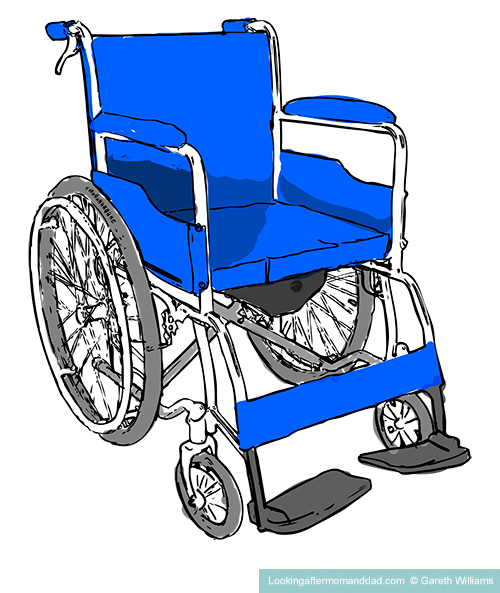
Self-propelled Transport Commode Chair
Shower chair and bedside transport commodes
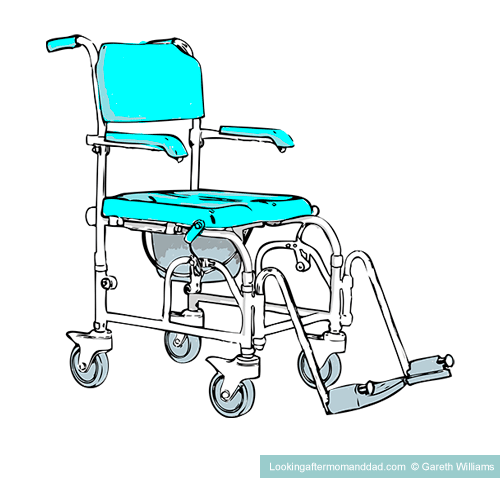
Attendant shower chair transport bedside commodes
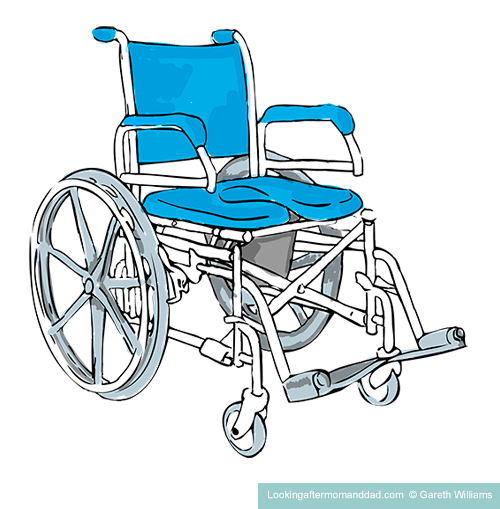
Self-propelled shower chair transport bedside commodes
If you want to learn more about rolling commodes, I have a very in-depth article with lots of examples of the different types, and you can find that article here. You will find the names, types, model numbers and weight capacities in the article, as well as suppliers.
Bedside commode liners
If you get a bedside commode, the best way of eliminating a lot of cleaning work is to use disposable commode liners with absorbent pads. A note of warning – if you don’t get the absorbent pads, you will still have to tip the bucket contents down the toilet. If you get the liners with pads, they absorb all the liquids, and you can put it all in the trash.
The liners are placed over the bucket of the commode and pop the absorbent pads in the bottom. The pads or powders used have gelling agents which will soak up any liquid in a matter of seconds, and absorb some odors.
Popular brands of disposable commode liners –
- Bearals – with or without absorbent pads
- Better Moments – without absorbent pads
- CareBag – with absorbent pads
- Carex – with absorbent powder
- Medline – with absorbent pads
- Medustry -with absorbent powder
- Reynard – with absorbent pads
- Sani Bag – with absorbent gelling agent
- Sani Care – without absorbent pads
- TidyCare – with or without absorbent pads
For my mom, we have used Carebag commode liners when we are not using the commode as a raised toilet seat, and have been perfectly happy with those.
Never flush these liners down the toilet.
Dispose of the commode liners in your landfill trash, as they are designed for that.
For those of you who have problems with, or are worried about, the odors often associated with a bedside commode, I have written, “Bedside Commode Odor Control: How To Keep It Smelling Sweet ?”. If you take care of things properly, you should have very few issues.
The article covers –
- what protective gear are you using ?
- cleaning products
- frequency of cleaning ?
- emptying the commode bucket ?
- properly preparing the commode bucket
- using multiple commode buckets
- proper handling of trash from the commode and incontinence products
- washable soft coverings and fabric
- air filters
- handling odors while you clean ?
- cleaning the bedside commode frame and seat
- how to stop a bedside commode from tipping over
- the benefits of bedside commodes
How to transfer from a bed to a bedside commode ?
For a person who is bedridden or unable to stand
For an individual who can’t stand, a bed transfer is best done with a transfer commode, which allows the person to slide over from the bed onto the commode.
A transfer commode with drop arms is very commonly used by wheelchair users, if they have a toilet which is not possible to safely access.
A bed transfer to transfer commode, for those who cannot stand or walk, is easiest with a variable height bed –
- the transfer commode is placed up against the side of the bed, with the extra side section up against the bed
- using your arms, slide over to the edge of the bed
- raise the height of the bed, making it is slightly higher than the commode, so that gravity will help you slide over onto the commode
- slide over onto the bedside commode
- when finished and cleaned, lower the height of the bed, to make it slightly lower than the transfer commode, using gravity to help you move on to the bed
- use your arms to slide you back over on to the bed
For a person who is able to stand
For those who have problems with their mobility, it is a very good idea to sit and stand using a walker to assist you.
To sit down on a bedside commode from a standing position using a walker –
- taking hold of the walker, use it to back up to the bedside commode
- keep holding onto the walker while backing up to maintain balance
- stop when the commode frame touches against the back of your legs
- for those of you who are assisting someone, you may need to help them lower any items of clothing
- remember when you go sit down, do not tilt the walker towards you
- now reach back with one hand to the armrest on that side
- reach for the other armrest with your other hand
- holding the armrests, lower yourself using your arms, sitting back on the bedside commode seat
- try not to sit down with a big jolt, as it may cause the commode to tip
- once seated, your feet should touch the ground – if they don’t, readjust the height of the commode legs
To stand up from a bedside commode using a walker –
- make sure that a walker is in front of the commode to hold onto when standing
- place both of your hands on the armrests and push up to stand
- reach forward with one hand and take a hold of the walker, and then take hold with the other
How to assist a person on a bedside commode
Once the person is seated on the commode, leave them to have a little privacy if they are safe to be on their own, but stay within earshot so that you can help them clean themselves, or give them a pager button or a bell to ring.
Helping a person if they can’t clean themselves –
- the person you are helping may not be able to clean themselves
- so have all provisions you need right there – you don’t want to have to wander off looking for items you forgot
- you will need toilet paper, wet wipes, gloves, warm water, soap and soft dry towels
- start by putting on the gloves
- help the person you are assisting to stand and have them hold the walker
- clean the person with toilet paper or wet wipes
- if the person you are helping is a woman, clean from front to back to prevent UTI’s
- after you have helped the person clean themselves, assist them back to bed
- remove all the used toilet paper and wet wipes into the trash and get that outside
- throw out the gloves you were wearing as well
- every time you have assisted someone with the toilet, don’t forget to wash your hands thoroughly with soap, it will stop bacteria from spreading
How to install a bedside commode to be used over a toilet ?
Placing a 3- in-1 or stacking bedside commode over a toilet, as well as being very practical for a lot of individuals also avoids all the unpleasant clean up afterwards.
To set up a 3- in-1 or stacking bedside commode over a toilet, you –
- remove the commode bucket from the bucket platform
- either remove your existing toilet seat, or put it into the upright position on your toilet
- adjust the height of the commode legs, so they are able to lift the seat of the commode high enough above the rim of your toilet bowl
- to set the length of a commode leg, you depress the spring-loaded buttons on the leg, and either pull the leg down to lengthen it, or push it up to make it shorter
- the legs must all be the same length for safety
- the spring-loaded buttons must pop out of the holes when height is set, they should click as they lock into position
- don’t make the bedside commode so high that the user’s feet are off the floor when seated, as this can lead to falls when the user tries to stand up
- once the legs are at the correct height, place the bedside commode over the toilet
- if the space between the commode frame and the rim of the toilet bowl is 3 or 4 inches, you may want to use the splash guard which came with your commode
- the splash guard slots into the bucket platform where the commode bucket goes when you are not using the bedside commode over a toilet
If you are looking for more information about using bedside commodes, you can find lots more in my article “Using A Bedside Commode: An Illustrated Guide”
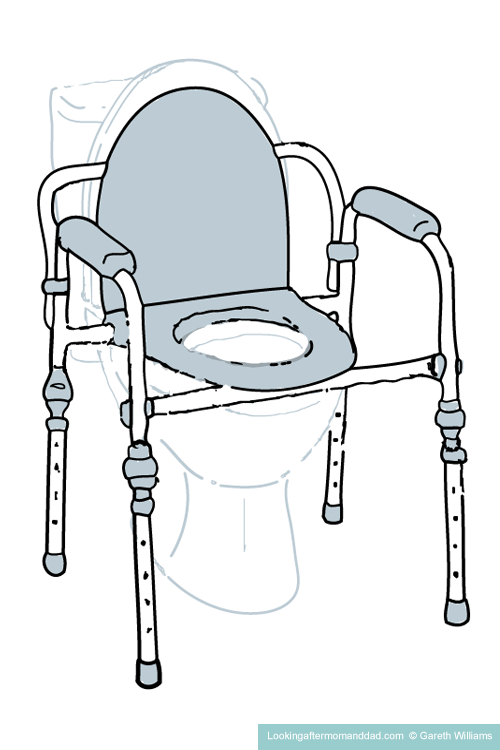
3 in 1 bedside commode installed over a toilet
If I managed to make the case for purchasing a bedside commode, you may find the two following articles of some use –
“How Much Does A Bedside Commode Cost ? A Guide With Over 160 Examples By Category”
and
I’m Gareth, the author and owner of Looking After Mom and Dad.com
I have been a caregiver for over 10 yrs and share all my tips here.

